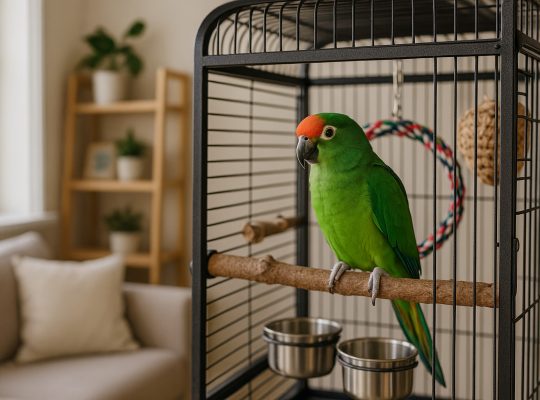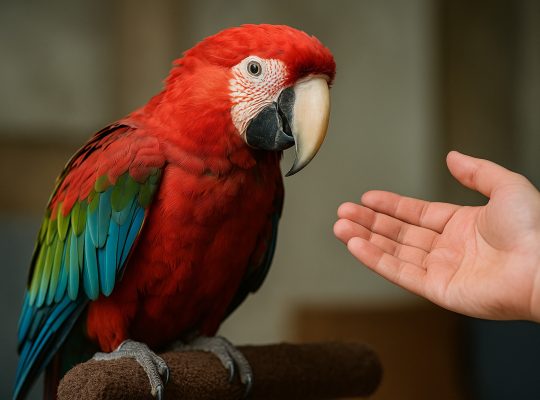Adopting a parrot in Canada is a rewarding process that requires careful planning and commitment. These intelligent birds need a lifelong home where they can thrive. Whether you’re considering a budgie, cockatoo, African grey, or macaw, the adoption journey involves more than simply picking a bird. This guide walks through each step, from research to final adoption, ensuring a smooth transition for both you and your new companion.
1. Understand the Commitment
Parrots are long-lived, social creatures that require daily interaction, proper nutrition, and mental stimulation. Some species can live 50–80 years, making them a lifetime responsibility. Consider these factors before deciding:
- Time and Attention: Parrots need several hours of interaction each day.
- Space: Large species require spacious cages and room to fly or climb.
- Noise Level: Some birds, like macaws and cockatoos, can be extremely loud.
- Costs: Expenses include food, vet care, toys, and a proper enclosure.
- Allergies and Household Suitability: Feather dust and dander can trigger allergies.
2. Research Different Parrot Species
Each parrot species has distinct personality traits, care needs, and space requirements. Choose a bird that matches your lifestyle:
- Budgies & Cockatiels: Ideal for first-time owners, lower maintenance.
- Conures & Quakers: Playful and affectionate but can be noisy.
- African Greys & Amazons: Highly intelligent, excellent talkers, require mental stimulation.
- Macaws & Cockatoos: Social and affectionate but need extensive care and space.
Spend time learning about different species before making a decision.
3. Find a Reputable Parrot Rescue or Adoption Center
Parrot rescues provide birds in need of a second chance, often due to previous owners being unprepared for their care. Some well-known organizations in Canada include:
- The Parrot Sanctuary (Toronto, ON) – Specializes in rehoming and rehabilitation.
- Greyhaven Exotic Bird Sanctuary (BC) – Rescues and adopts various parrot species.
- The Parrot Club (QC) – Works with abandoned and surrendered birds.
- Parrot Adoptions Ontario (ON) – Facilitates responsible adoptions.
Avoid pet stores and breeders focused on profit. Ethical adoption ensures a home for birds that need it most.
4. Prepare for the Adoption Process
Rescues have strict requirements to ensure the best match. Be ready for:
- An Application: Questions about your experience, home setup, and expectations.
- A Home Visit: Some organizations assess your space for safety and suitability.
- Educational Sessions: Training on handling, nutrition, and behavior.
- A Trial Period: Some rescues allow a temporary placement before finalizing adoption.
Be patient. Some birds require specific environments, and approval may take time.
5. Set Up a Safe and Enriching Environment
Before bringing your parrot home, create a space that meets its physical and mental needs.
Cage Requirements
- Spacious enough for the bird to fully stretch wings and move around.
- Horizontal bars for climbing and sturdy locks to prevent escapes.
- Placed in a social area but away from kitchens and direct sunlight.
Toys and Mental Stimulation
Parrots are problem-solvers that need variety:
- Puzzle toys and foraging challenges.
- Chewable materials like wood and rope.
- Rotating toys to prevent boredom.
Proper Diet
- Fresh fruits, vegetables, grains, and high-quality pellets.
- Limited seeds and nuts due to fat content.
- No chocolate, avocado, caffeine, or alcohol—these are toxic.
6. Learn Basic Training and Socialization
Training helps establish trust and encourages good behavior.
- Positive Reinforcement: Use treats and praise instead of punishment.
- Handling Techniques: Let the bird come to you rather than forcing interaction.
- Socialization: Introduce family members gradually to build comfort.
- Vocalization Management: Encourage talking and discourage excessive screaming.
Parrots are emotional creatures and need routine interaction. Spend time each day engaging with your bird.
7. Schedule Regular Veterinary Checkups
Exotic bird vets are necessary for proper health care. A checkup should be scheduled immediately after adoption and then annually.
Common health concerns include:
- Feather Plucking: Often caused by stress or nutritional deficiencies.
- Respiratory Infections: Symptoms include sneezing, nasal discharge, and wheezing.
- Beak & Nail Overgrowth: Regular maintenance prevents issues.
Find a certified avian veterinarian near you before bringing your parrot home.
8. Allow Time for Adjustment
Every parrot adjusts at its own pace. Some may be comfortable within days, while others need months.
The First Few Days
- Keep interactions gentle and let the bird observe from its cage.
- Offer treats and talk softly to build trust.
- Avoid excessive handling—allow the bird to initiate contact.
Signs of a Comfortable Parrot
- Relaxed posture and preening.
- Engaging with toys and eating normally.
- Responding to your voice with chirps or mimicry.
Patience is key. Bonding happens over time, not overnight.
9. Join a Parrot Community
Connecting with other parrot owners provides valuable insights and support. Consider:
- Online Forums: Avian Avenue, Parrot Forum, and Canadian Parrot Facebook groups.
- Local Parrot Clubs: Many cities have bird meet-ups and education events.
- Rescue Support Groups: Continued guidance from the adoption center.
Learning from experienced owners helps in handling challenges and improving care.
10. Commit to a Lifetime of Care
Parrots form deep bonds with their caregivers. They need consistency, patience, and love throughout their lives.
Long-Term Responsibilities
- Provide daily interaction and mental stimulation.
- Maintain a clean and safe living environment.
- Adjust care as the bird ages, ensuring comfort in later years.
- Have a plan for long-term care, especially for species with lifespans exceeding 50 years.
Parrot adoption is a long-term commitment that brings years of companionship. With proper care, your bird will become an irreplaceable part of your life.



